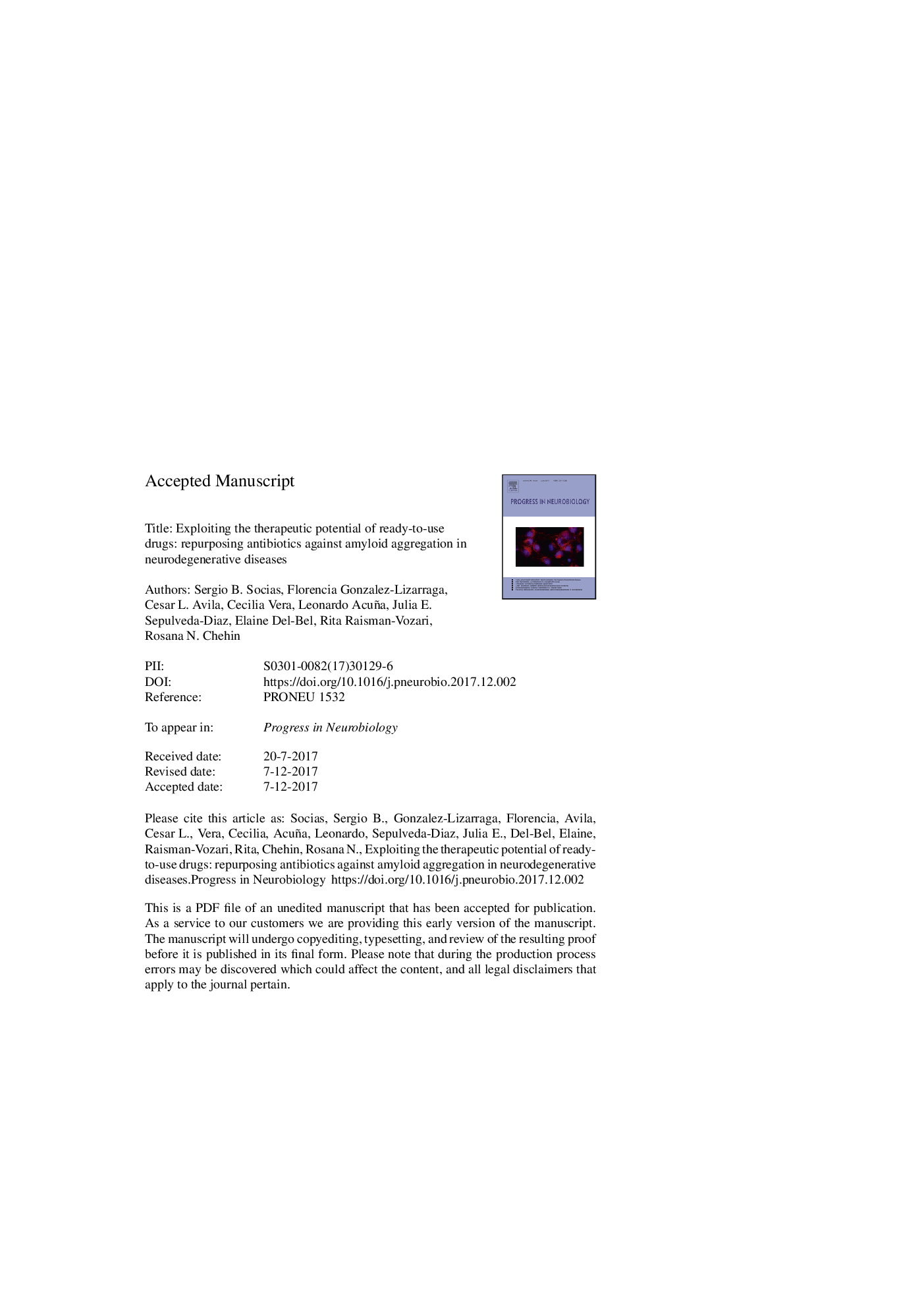| کد مقاله | کد نشریه | سال انتشار | مقاله انگلیسی | نسخه تمام متن |
|---|---|---|---|---|
| 8842188 | 1615353 | 2018 | 98 صفحه PDF | دانلود رایگان |
عنوان انگلیسی مقاله ISI
Exploiting the therapeutic potential of ready-to-use drugs: Repurposing antibiotics against amyloid aggregation in neurodegenerative diseases
ترجمه فارسی عنوان
بهره برداری از پتانسیل های درمانی داروهای آماده برای مصرف: دفع آنتی بیوتیک ها در برابر تجمع آمیلوئید در بیماری های نوروژنیک
دانلود مقاله + سفارش ترجمه
دانلود مقاله ISI انگلیسی
رایگان برای ایرانیان
کلمات کلیدی
AβMPTPTSEsMCsDCsPrPSOD1GAPDHNFTd-cycloserineAMBDOXLPSCJD1-methyl-4-phenyl-1,2,3,6-tetrahydropyridine - 1-methyl-4-phenyl-1،2،3،6-tetrahydropyridineSNpc - SNPCAmphotericin B - آمفوتریسین BAntibiotic - آنتی بیوتیکهاamyotrophic lateral sclerosis - اسکلروز جانبی آمیوتروفیکTransmissible spongiform encephalopathies - انسفالوپاتی های اسپگوماییک قابل انتقالThT - بلهALS - بیماری اسکلروز جانبی آمیوتروفیکAmyloid aggregation - تجمع آمیلوئیدsubstantia nigra pars compacta - توده سیاه پارس متراکمThioflavin T - تیوفلاوین TDrug repurposing - داروهای تجویزیDoxorubicin - دوکسوروبیسینBBB - سد خونی مغزیSuperoxide dismutase - سوکسوکس دیسموتازCerebral Spinal Fluid - سیالات مغزی نخاعیlipopolysaccharide - لیپوپلی ساکاریدBlood-brain barrier - مانع خون مغزیCSF - مایع مغزی نخاعیNeuroprotection - محافظت نورونی یا محافظت از عصبneurofibrillary tangles - مگس های نوروفیبریلیالAmyloid β peptide - پتید بتا آمیلوئیدPrion protein - پروتئین پریونGramicidin S - گرمیسییدین SGeldanamycin - گلدنامیسینglyceraldehyde-3-phosphate dehydrogenase - گلیسرالیدید-3-فسفات دهیدروژناز
ترجمه چکیده
بیماری های نوروژنیک ناشی از اختلالات مزمن و پیشرفته است که بر مناطق خاص مغز اثر می گذارند، باعث ناتوانی تدریجی و رنج می شود که ناشی از عدم توانایی کامل بیماران برای انجام کارهای روزانه می باشد. تجمع آمیلوئید پروتئین های خاصی شایعترین رخداد بیولوژیکی است که مسئول مرگ مرگ مغز و تولید عصب در بیماری های عصبی - عامل های درمانی که قادر به تجمع غیر طبیعی می باشند، مورد نیاز است، اما کشف داروهای سنتی کوتاه است. اکتشاف استفاده های جدید برای داروهای تایید شده یک جایگزین مفید برای پر کردن فاصله بین شیوع افزایش بیماری های نورودنراتیو و ارزیابی دراز مدت تکنولوژی کشف داروهای کلاسیک است. بازنگری مواد مخدر در حال حاضر سریعترین امکان انتقال از نیمکت به بالشتک است. به این ترتیب، شواهد تجربی نشان می دهد که برخی از ترکیبات آنتی بیوتیک فعالیت ضد عفونی را از طریق فعالیت ضد انباشته در پروتئین های مرتبط با بیماری اعمال می کنند. یافته های بسیاری از آنتی بیوتیک ها می تواند از مانع خونریزی مغزی عبور کند و برای چندین دهه بدون اثرات شدید سمی مورد استفاده قرار گیرد و آنها را به عنوان جایگزین عالی برای تغییر درمانی به اختلالات عصبی تبدیل می کند. بررسی حاضر، به نظر ما، اولین بررسی گسترده و تجزیه و تحلیل اثر ضد آمیلوئیدوژنیک آنتی بیوتیک های مختلف در پروتئین شناخته شده مرتبط با بیماری است. علاوه بر این، ما یک نشریه ساختاری مشترک را که از مولکول های آنتی بیوتیک آنتی بیوتیک است که می تواند به کشف علمی مواد مخدر مرتبط باشد پیشنهاد می کنیم.
موضوعات مرتبط
علوم زیستی و بیوفناوری
علم عصب شناسی
علوم اعصاب (عمومی)
چکیده انگلیسی
Neurodegenerative diseases are chronic and progressive disorders that affect specific regions of the brain, causing gradual disability and suffering that results in a complete inability of patients to perform daily functions. Amyloid aggregation of specific proteins is the most common biological event that is responsible for neuronal death and neurodegeneration in various neurodegenerative diseases. Therapeutic agents capable of interfering with the abnormal aggregation are required, but traditional drug discovery has fallen short. The exploration of new uses for approved drugs provides a useful alternative to fill the gap between the increasing incidence of neurodegenerative diseases and the long-term assessment of classical drug discovery technologies. Drug re-profiling is currently the quickest possible transition from bench to bedside. In this way, experimental evidence shows that some antibiotic compounds exert neuroprotective action through anti-aggregating activity on disease-associated proteins. The finding that many antibiotics can cross the blood-brain barrier and have been used for several decades without serious toxic effects makes them excellent candidates for therapeutic switching towards neurological disorders. The present review is, to our knowledge, the first extensive evaluation and analysis of the anti-amyloidogenic effect of different antibiotics on well-known disease-associated proteins. In addition, we propose a common structural signature derived from the antiaggregant antibiotic molecules that could be relevant to rational drug discovery.
ناشر
Database: Elsevier - ScienceDirect (ساینس دایرکت)
Journal: Progress in Neurobiology - Volume 162, March 2018, Pages 17-36
Journal: Progress in Neurobiology - Volume 162, March 2018, Pages 17-36
نویسندگان
Sergio B. Socias, Florencia González-Lizárraga, Cesar L. Avila, Cecilia Vera, Leonardo Acuña, Julia E. Sepulveda-Diaz, Elaine Del-Bel, Rita Raisman-Vozari, Rosana N. Chehin,
